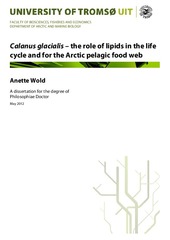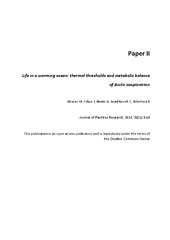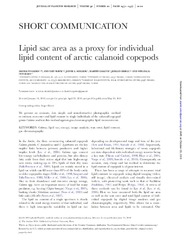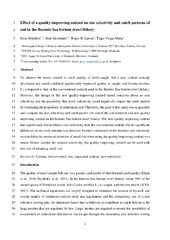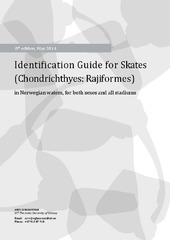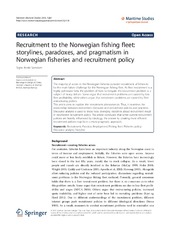Blar i tittel Doktorgradsavhandlinger (BFE-fak)
Viser treff 43-62 av 271
-
Calanus glacialis : the role of lipids in the life cycle and for the Arctic pelagic food web
(Doctoral thesis; Doktorgradsavhandling, 2012-05-23)The Arctic marine ecosystem is characterized by strong seasonality and a short but productive period of primary production in the spring when the ice breaks up. Calanus glacialis is one of the key links between primary producers and higher trophic levels, and it is adapted to the strong seasonality by life cycle traits such as; seasonal vertical migration, diapausing, reproduction in the spring and ... -
Calanus glacialis and C. finmarchicus in a warming Arctic Implications of increasing temperature at the individual and population level
(Doctoral thesis; Doktorgradsavhandling, 2017-03-21)Climate change is particularly pronounced in the Arctic and water temperatures are predicted to increase substantially. This has important implications for Arctic marine organism, especially ectotherms, such as copepods. The calanoid copepods Calanus glacialis and C. finmarchicus are key species of different pelagic food webs at high latitudes and changes in temperature will likely affect them ... -
Calanus oil and its constituents as a therapeutic approach to target obesity-induced metabolic distortions
(Doctoral thesis; Doktorgradsavhandling, 2023-11-24)Obesity is one of the leading causes for the development of metabolic disorders, such as insulin resistance and type 2 diabetes. Omega-3 fatty acids, found in seafood and marine oils, are shown to reduce obesity, lower blood lipid levels, change the composition of the gut microbiota and reduce the risk for cardiovascular diseases. The increased demand for seafood and marine oils has put pressure on ... -
Calanus spp. in the Arctic ecosystem - a story on predation, distribution and methodology
(Doctoral thesis; Doktorgradsavhandling, 2014-11-19)The calanoid copepods of the genus Calanus (C. finmarchicus, C. glacialis and C. hyperboreus) are key elements in the Arctic ecosystem. They link primary producers (ice algae, phytoplankton) and higher trophic levels through their ability to convert low energy carbohydrates and proteins to high energy wax esters. This energy is stored in a separate and conspicuous lipid sac. This ability to store ... -
Calanus® Oil. Utilization, composition and digestion
(Doctoral thesis; Doktorgradsavhandling, 2016-07-03)In the pelagic system, phytoplankton are the main producers of n-3 LC-PUFA and make up the foundation of the oceanic food web. Zooplankton, such as copepods and krill, are the most numerous primary consumers in the marine environment and have a central role in the energy transfer to higher trophic levels. The copepod Calanus finmarchicus is present in large amounts in the North Atlantic and has ... -
Catch quality and size selectivity in the Barents Sea bottom trawl fishery: effect of codend design and trawling practice
(Doctoral thesis; Doktorgradsavhandling, 2019-02-15)This study focused on two important issues on the Barents Sea bottom trawl fishery for Northeast Arctic cod (Gadus morhua L.); catch quality (i.e., the quality of the fish caught) and size selectivity. The high abundance of cod encountered in recent years in the Barents Sea, leading to subsequent large annual quotas, has led to increased interest in improving the quality of fish caught by trawls. ... -
Catch quality of Northeast Atlantic cod (Gadus morhua) caught by bottom trawl and gillnet – Effects of changes in gear design and fishing practices
(Doctoral thesis; Doktorgradsavhandling, 2022-10-07)<p>Cod caught with bottom trawls and gillnets have often been associated with poor and variable quality, and little is known about how changes in gear design and fishing practices may influence the quality of fish caught by these two fishing gears. It is difficult, if not impossible, to improve catch quality if fish are damaged during the capture process. Therefore, preventing the deterioration of ... -
Cellular responses induced by environmental stress factors in Arctic Seabird chicks : Responses of the antioxidant defense system and autophagic lysosomal processes related to contaminant exposure and food restriction
(Doctoral thesis; Doktorgradsavhandling, 2011-11-29)This PhD study has investigated how two commonly occurring environmental stress factors in the Arctic (periods with little food and exposure to halogenated organic contaminants) have had an impact on two important cellular defense mechanisms in Arctic seabirds. The antioxidant defense system and autophagic lysosomal responses in liver cells of Arctic seabird chicks have been studied. Samples ... -
Challenges for ice-associated top trophic Arctic animals in a changing climate
(Doctoral thesis; Doktorgradsavhandling, 2017-02-17)The Arctic is currently in a rapid state of change, with temperature increases in this region being three times the rate of the global average and sea-ice extent declining rapidly. In 2006, a sudden shift in the sea-ice regime in Svalbard, Norway, occurred with the altered sea-ice conditions persisting to the present day. In order to study the impacts of the environmental changes occurring in the ... -
The challenges of understanding the biogeography of commercially important crustacean species of the Southwestern Indian Ocean — Separating what we know from what we think we know.
(Doctoral thesis; Doktorgradsavhandling, 2020-05-25)Demersal trawl fisheries play an important role in providing income and protein to the people of the Southwestern Indian Ocean (SWIO). These fisheries are very destructive to the habitats in which they operate and have an impact on the associated biodiversity. Three crustacean species, knife prawn (<i>Haliporoides triarthrus</i>), African langoustine (<i>Metanephrops mozambicus</i>) and pink geryon ... -
Changing Business models for Sustainability: Role of drivers and dynamic capabilities in Arctic nature tourism
(Doctoral thesis; Doktorgradsavhandling, 2023-01-31)<p>This thesis investigates nature tourism companies, which strive to incorporate sustainability into their business models and change them to be more resilient. For this purpose, it adopts a dynamic perspective on business models by which companies address corporate sustainability which is understood here as a balance among environmental, social, and economic pillars as well as a sustainable ... -
Characterization of a Cytokinin Response Factor in Arabidopsis thaliana
(Doctoral thesis; Doktorgradsavhandling, 2012-05-15)Acclimation responses to environmental growth conditions in plants involve complex and fine-tuned signalling networks. Environmental signals, biotic and abiotic, are received and mediated, and lead eventually to transcriptional regulation. The plant hormones are vastly involved in these processes as intercellular mediators whereas the reception of such a hormone at the site of action involves ... -
Chondrichthyan fishes in the Arctic Ocean and adjacent seas - do we know our species?
(Doctoral thesis; Doktorgradsavhandling, 2014-10-31)The basal prerequisite for managing species and understanding ecosystems is correct species and population identification. Without knowing the species, we cannot with accuracy detect changes in distribution or abundance due to climate change, fisheries, diseases or any other types of impact. This thesis gives the first complete overview of chondrichthyan fishes (sharks, skates, rays and chimaeras), ... -
Circadian-based processes in the High Arctic: activity, thermoregulation and photoperiodism in the Svalbard ptarmigan (Lagopus muta hyperborea)
(Doctoral thesis; Doktorgradsavhandling, 2021-04-15)<p>This thesis addresses aspects of the circadian and photoperiodic system in a High Arctic bird: the Svalbard ptarmigan (<i>Lagopus muta hyperborea</i>, Sundevall 1845). The most northern resident bird inhabits a unique photic environment; 2/3 of its year it spends either under a night without sunrise (polar night) or under a never setting Sun (polar day). Studies so far suggest a temporal loss of ... -
Climate change impact on high latitude freshwater fish populations
(Doctoral thesis; Doktorgradsavhandling, 2021-11-12)<p>Climate change is one of the greatest threats to animal wildlife in high latitude freshwater ecosystems. Climate warming is rapidly increasing water temperatures in these areas, affecting biological processes of ectotherms such as growth, maturation and reproduction, which in turn trigger population responses. The magnitude of the effects of climate warming will vary depending on the thermal niche ... -
Climate warming impact on the deep demersal fish community East of Greenland
(Doctoral thesis; Doktorgradsavhandling, 2022-04-06)This thesis presents a study of the impact of climate warming on deep demersal fish communities East of Greenland, in a transition zone between Atlantic and Arctic waters. Climate change was expected to affect fish community composition and functional characterization via poleward distributional shifts and changes in abundance. To assess the climate driven effects on fish communities, I used long ... -
Coastal Communities and Employment Systems: Networks and communities in change
(Doctoral thesis; Doktorgradsavhandling, 2013-11-29)Gitt at norske fiskerier har gjennomgått store endringer side 1970-tallet, med utgangspunkt i Jentoft and Wadel (1984), utforsker dette arbeidet det moderne sysselsettingssystemet på kysten, hvordan det har endret seg og hva effekten har vært på kystsamfunn. Studien viser at relasjonene mellom fiskeriene og kystsamfunnene har endret seg. På 1970-talet var sysselsettingssystemet preget av et helhetlig ... -
Conceptualizing fishery systems: A mental models approach
(Doctoral thesis; Doktorgradsavhandling, 2022-04-22)Thinking of fisheries as a system is a relatively new approach in fisheries science and management. As part of my contribution to this perspective, this thesis uses mental models as a new approach to gain insights into how individuals conceptualize fisheries. Mental models are internal representations of the surrounding world (e.g., phenomena, processes, problems) and they are important because these ... -
Consideration set size and choice in fish consumption : the influence of attitude, knowledge, convenience, and category presentation
(Doctoral thesis; Doktorgradsavhandling, 2010-06-11)<i>Purpose</i> – Three main objectives are defined in this thesis: 1) To determine the extent to which the nature of a consideration set affects consumer choice; 2) To investigate how consumer attitudes, knowledge, and convenience motivations affect the formation of a consideration set; and 3) To investigate how category presentation moderates the relationship between convenience motivations and ... -
Consumers’ Value Perceptions of Seafood
(Doctoral thesis; Doktorgradsavhandling, 2022-04-08)Consumers’ perception of seafood products plays a critical role in determining their consumption behaviour. As a great quantity of seafood is produced by aquaculture, specifically farmed fish, consumers’ perception of farmed fish is crucial. In recent years, consumers in developing and emerging countries have increased their concern about seafood safety. This thesis investigates consumers’ ...


 English
English norsk
norsk